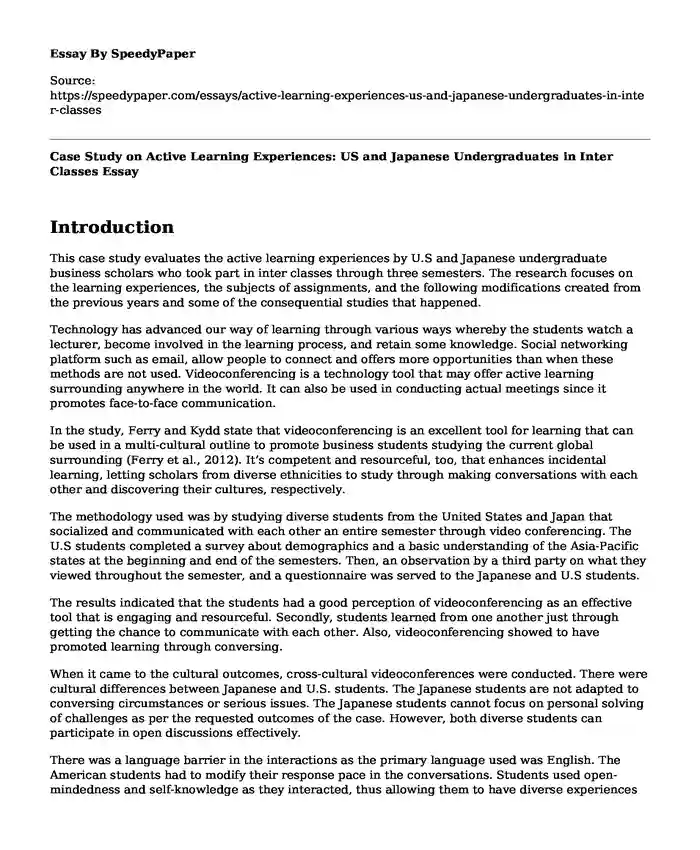Introduction
This case study evaluates the active learning experiences by U.S and Japanese undergraduate business scholars who took part in inter classes through three semesters. The research focuses on the learning experiences, the subjects of assignments, and the following modifications created from the previous years and some of the consequential studies that happened.
Technology has advanced our way of learning through various ways whereby the students watch a lecturer, become involved in the learning process, and retain some knowledge. Social networking platform such as email, allow people to connect and offers more opportunities than when these methods are not used. Videoconferencing is a technology tool that may offer active learning surrounding anywhere in the world. It can also be used in conducting actual meetings since it promotes face-to-face communication.
In the study, Ferry and Kydd state that videoconferencing is an excellent tool for learning that can be used in a multi-cultural outline to promote business students studying the current global surrounding (Ferry et al., 2012). It’s competent and resourceful, too, that enhances incidental learning, letting scholars from diverse ethnicities to study through making conversations with each other and discovering their cultures, respectively.
The methodology used was by studying diverse students from the United States and Japan that socialized and communicated with each other an entire semester through video conferencing. The U.S students completed a survey about demographics and a basic understanding of the Asia-Pacific states at the beginning and end of the semesters. Then, an observation by a third party on what they viewed throughout the semester, and a questionnaire was served to the Japanese and U.S students.
The results indicated that the students had a good perception of videoconferencing as an effective tool that is engaging and resourceful. Secondly, students learned from one another just through getting the chance to communicate with each other. Also, videoconferencing showed to have promoted learning through conversing.
When it came to the cultural outcomes, cross-cultural videoconferences were conducted. There were cultural differences between Japanese and U.S. students. The Japanese students are not adapted to conversing circumstances or serious issues. The Japanese students cannot focus on personal solving of challenges as per the requested outcomes of the case. However, both diverse students can participate in open discussions effectively.
There was a language barrier in the interactions as the primary language used was English. The American students had to modify their response pace in the conversations. Students used open-mindedness and self-knowledge as they interacted, thus allowing them to have diverse experiences while talking to different cultural individuals at the videoconference.
A Manager-Friendly Heuristic Model for Resolving Cross-Cultural Ethical Conflicts
In this case, study a set of heuristic questions integrated into a model to understand the methods that can be used to multi-cultural ethical differences. This HKH (Hamilton, Knouse, Hill) model is meant to be used by Multinational Enterprise (MNE) managers who have to focus on the morals used by his business or firm as matched to the values practiced by the host nation. The model provides an official “management decision process” on how to proceed with a discussion in the enterprise, firm, or business when a multi-cultural ethical engagement happens.
The HKH decision necessitates that the MNE managers pose six heuristic questions to create effective feedback when the enterprise’s actions are different from the host nation’s practices. The decision-making tree has three kinds of results. The first outcome dictates that the firm should adhere to their actions (firm’s way); the second outcome states that the enterprise/firm should follow the host’s practices (host’s way). The third outcome advises the manager not to do business in a foreign country (the highway) (Hamilton et al., 2009).
The model was then applied by a Google management team to discuss the firm’s capability to enter China. The company would be established in a country with diverse culture and with different regulations, which makes the company act differently. The Google managers would answer the six heuristic questions on bases based on operations of the questionable practice (QP). The HKH approach can also be used in creating compact values and ethics plans and also be used in formulating actions that can be used in a region or nation that shows possible ethical problems.
The Benefits of Cross-Cultural Management in Business.
Cross-cultural management in business assists us in comprehending people originating from diverse cultures. It is essential because most companies today are expanding their businesses to a global market. In today’s world, managers have to deal with individuals and clients from diverse countries, whose culture is distinct from the domestic country. Many organizations have also discovered that diversification can promote the effectiveness of the organization. However, to get better advantages, an organization has to make effective strategies and straight forward initiatives that will make the company be entirely a multi-cultural enterprise.
Conclusion
These two case studies have shown that multicultural differences are present within several areas of life. It is best for firms and organizations to formulate various strategies and frameworks to allow workforce diversity. Cultural management has to be implemented in organizations for better advantages in the long-term and also allow better understanding and prevent conflicts within the human resource area.
References
Ferry, D. L., Kydd, C. T., & Boyles, C. (2012). Creating the global graduate: A CrossCultural videoconferencing case study. Decision Sciences Journal of Innovative Education, 10(2), 139-164. https://doi.org/10.1111/j.1540-4609.2011.00336.x
Hamilton, J. B., Knouse, S. B., & Hill, V. (2009). Google in China: A manager-friendly heuristic model for resolving cross-cultural ethical conflicts. Journal of Business Ethics, 86(2), 143-157. https://doi.org/10.1007/s10551-008-9840-y
Cite this page
Case Study on Active Learning Experiences: US and Japanese Undergraduates in Inter Classes. (2023, Nov 14). Retrieved from https://speedypaper.net/essays/active-learning-experiences-us-and-japanese-undergraduates-in-inter-classes
Request Removal
If you are the original author of this essay and no longer wish to have it published on the SpeedyPaper website, please click below to request its removal:
- Philosophical Essay Example
- Core Managerial Skills - Faculty of Law Admission Essay Sample
- Contemporary Society in Application Essay Example
- Is Failing Students in Schools a Harmful Practice or Advantagious? Education Essay Sample
- Clearwater Case Study, Free Essay
- Free Essay - Critical Issues in Teaching Young Children with Learning Disabilities
- Essay on Exploring Learning Experiences: Outdoor Activities, Music, Art, and Math for Children
Popular categories





